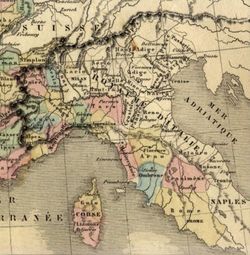- Department of Alto Adige
-
Dipartimento dell'Alto Adige District, Department of the Cisalpine Republic and Kingdom of Italy (Napoleonic) 1797–1798, 1810–1814 French map of Napoleonic Italy, with the department of Alto Adige (French: Haut-Adige) located in the north Capital Trento History - Established 1797–1798, 1810 - Disestablished 1814 The Department of Alto Adige (French: Haut-Adige, German: Ober-Etsch, English: Upper Adige[1]) was a northern department of the Napoleonic Kingdom of Italy. The name previously had been used for a district of the Cisalpine Republic. Its name, in typical Napoleonic fashion of naming departments after geographic features, derived from the river Adige (Etsch) which flowed through it.
Neither the Cisalpine district nor the department of the Kingdom of Italy correspond precisely to the modern Italian province of South Tyrol (also known as Alto Adige), although there is some geographical overlap.
Contents
History
Cisalpine Republic
The district of Alto Adige was created as a part of the short-lived Department of Benaco in the Cisalpine Republic, and included the municipality of Zevio,[2][3] which is now in the Province of Verona. The department of Benaco, which was created in 1797, was disbanded in 1798 after a structural reorganization of the republic.
Kingdom of Italy
The department of Alto Adige was created after the partition of the County of Tyrol between Bavaria and the Kingdom of Italy on 9 June 1810 by Napoleon Bonaparte. At this point the county already included the Bishopric of Brixen and the Bishopric of Trent. Whereas the Cisalpine district was located to the south of the County of Tyrol, the new department comprised the southern part of Tyrol downstream of Barbian (south of Klausen) and Gargazon/Lana and Trentino, southern Tyrol and its surroundings including the South Tyrolean Unterland and the Fascia Valley.
The remaining northern part of the ancient county of Tyrol was divided between the Kingdom of Bavaria as part of the Confederation of the Rhine, in addition to Innsbruck and the Inn valley including Meran, Sterzing, Brixen, Klausen, Bruneck, the northern Eisack, Vinschgau and Puster valleys up to Welsberg-Taisten. The Illyrian provinces were extended to Lienz and East Tyrol, the eastern part of the Pustertal and the Piave department (which included Livinallongo del Col di Lana and Ampezzo).
Its capital was Trent and the administrative language Italian, but the German-speaking areas temporarily adopted bilingualism in the public notices and used German in city government. The department was known in German as "Ober-Etsch".[4]
The department was disbanded after the defeat of Napoleon in 1814. Its territory is presently divided over the Italian autonomous provinces of Trentino and South Tyrol.
Reuse of name
The name "Alto Adige" had no historical antecedent nor the region it denoted, but merely described the geographic area of the upper reaches of the Adige river. This was something that was commonly done during the Napoleonic period when naming departments, ignoring any historical names or connotations. The name was dropped after the end of the Napoleonic period. The term "Alto Adige" was later used as the Italian name of the province of South Tyrol, its geographic definition yet again shifting to the north, by the Fascist Ettore Tolomei in his Italianization campaign. He purposely left out the Trentino and only applied the term to South Tyrol. When southern Tyrol was annexed after the end of World War I from Austria to Italy in 1919, the term "Alto Adige" was applied instead of the proposed "Italian Tyrol" (Tirolo Italiano) or "Tridentine Tyrol" (Tirolo trentino), and made official by the fascist regime in 1923.
References
- ^ The history of the reign of George III at Google Books
- ^ Cisalpine Republic (1797) (in Italian). Raccolta delle leggi, proclami, ordini ed avvisi, Vol 4. Milan: Luigi Viladini. p. 201. http://books.google.com/books?id=Gy5FAAAAYAAJ&pg=PA201#v=onepage&q=Alto%20Adige&f=false.
- ^ Cisalpine Republic (1798) (in Italian). Raccolta delle leggi, proclami, ordini ed avvisi, Vol 5. Milan: Luigi Viladini. p. 184. http://books.google.com/books?id=1RDgAAAAMAAJ&pg=PA184&dq=%22alto+adige%22+benaco+-torri+-trentino&hl=en&ei=s2AkTqjzNMLg0QGP3PmmAw&sa=X&oi=book_result&ct=result&resnum=7&ved=0CEsQ6AEwBg#v=onepage&q=%22alto%20adige%22%20benaco%20-torri%20-trentino&f=false.
- ^ Bertuch, Friedrich Justin (1813) (in German). Allgemeine geographische Ephemeriden, Vol. 40. Weimar: Verlage des landes-Industrie comptoirs. p. 168. http://books.google.com/books?id=i-ABAAAAYAAJ&pg=PA168&dq=%22ober+etsch%22+adige&hl=en&ei=tGE0TvWjNYPz0gGt5MCDDA&sa=X&oi=book_result&ct=result&resnum=1&ved=0CCwQ6AEwAA#v=onepage&q=%22ober%20etsch%22%20adige&f=false.
Further reading
- Reinhard Stauber, Der Zentralstaat an seinen Grenzen. Administrative Integration, Herrschaftswechsel und politische Kultur im südlichen Alpenraum 1750-1820 (Schriftenreihe der Historischen Kommission der Bayerischen Akademie der Wissenschaften, 64), Göttingen, Vandenhoeck & Ruprecht, 2001. ISBN 978-3-525-36057-6
Categories:- States and territories disestablished in 1814
- History of South Tyrol
- History of Trentino
- Italian history stubs
- French history stubs
Wikimedia Foundation. 2010.

